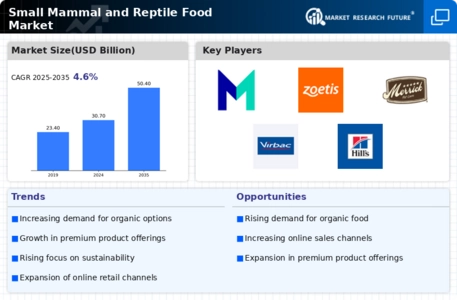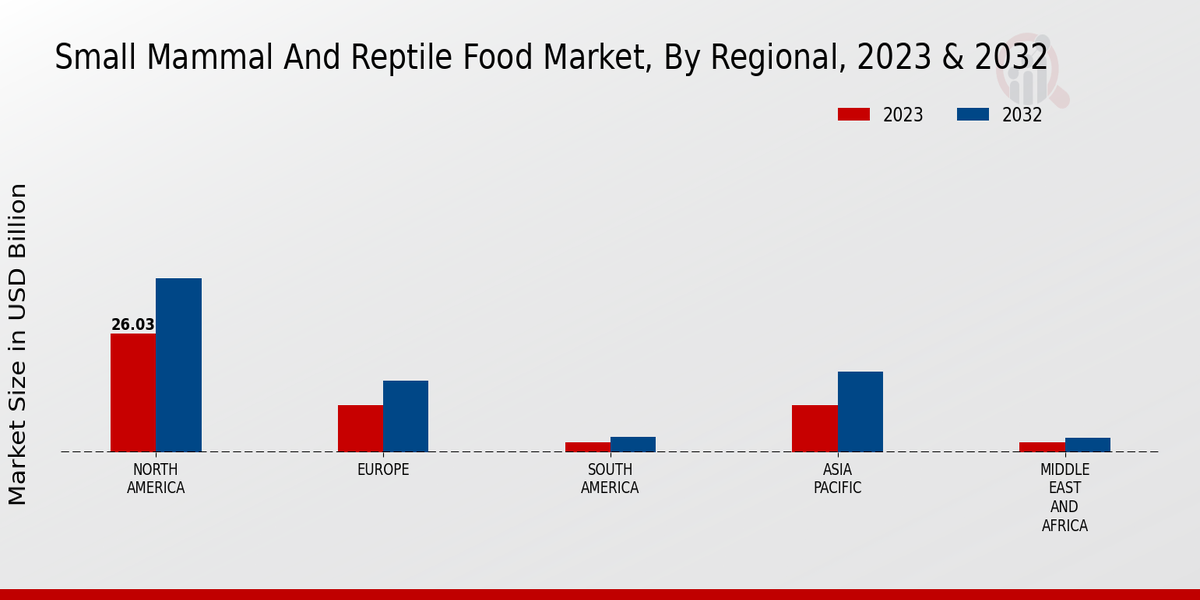E-commerce Growth
The Global Small Mammal and Reptile Food Market Industry is witnessing a significant shift towards e-commerce platforms for purchasing pet food. The convenience of online shopping, coupled with the ability to access a wider range of products, appeals to modern consumers. This trend is particularly pronounced among younger demographics who prefer the ease of ordering pet supplies online. As e-commerce continues to expand, it is expected to play a pivotal role in shaping the market landscape. The growth of online sales channels is likely to enhance market accessibility and drive overall sales, contributing to the projected market value of 30.7 USD Billion in 2024.
Rising Pet Ownership
The Global Small Mammal and Reptile Food Market Industry experiences growth due to the increasing trend of pet ownership worldwide. As more households adopt small mammals and reptiles as pets, the demand for specialized food products rises. In 2024, the market is projected to reach 30.7 USD Billion, reflecting the growing consumer interest in providing quality nutrition for these animals. This trend is particularly evident in urban areas where space constraints lead to a preference for smaller pets. The focus on pet health and wellness further drives this market, as owners seek premium food options tailored to the dietary needs of their pets.
Market Growth Projections
The Global Small Mammal and Reptile Food Market Industry is projected to experience substantial growth over the coming years. With an estimated market value of 30.7 USD Billion in 2024, the industry is set to expand significantly, reaching 50.4 USD Billion by 2035. This growth trajectory suggests a robust demand for small mammal and reptile food products, driven by factors such as increasing pet ownership, health trends, and innovation in product offerings. The anticipated CAGR of 4.62% from 2025 to 2035 further underscores the potential for sustained growth in this market, indicating a favorable environment for both existing and new market participants.
Health and Wellness Trends
The Global Small Mammal and Reptile Food Market Industry is significantly influenced by the health and wellness trends among pet owners. Consumers are increasingly aware of the nutritional requirements of their pets, leading to a demand for high-quality, natural, and organic food products. This shift towards healthier options is evident in the rising sales of premium pet food brands that emphasize quality ingredients. As the market evolves, it is expected that the CAGR will reach 4.62% from 2025 to 2035, indicating a sustained interest in health-conscious pet food solutions. This trend not only enhances the quality of life for pets but also aligns with broader consumer preferences for sustainable and ethical products.
Sustainability Initiatives
Sustainability initiatives are becoming increasingly relevant within the Global Small Mammal and Reptile Food Market Industry. Consumers are showing a preference for brands that prioritize environmentally friendly practices, such as sustainable sourcing of ingredients and eco-friendly packaging. This shift towards sustainability not only reflects changing consumer values but also encourages manufacturers to adopt responsible practices. As the market evolves, companies that embrace sustainability are likely to gain a competitive advantage. This trend aligns with the broader movement towards ethical consumerism, which is expected to influence purchasing decisions and contribute to the market's growth trajectory.
Innovative Product Development
Innovation plays a crucial role in the Global Small Mammal and Reptile Food Market Industry, as manufacturers continuously develop new products to meet the evolving needs of pet owners. This includes the introduction of specialized diets that cater to specific species and life stages, as well as the incorporation of functional ingredients that promote health benefits. For instance, products enriched with probiotics or vitamins are gaining traction among consumers. The focus on innovation is likely to contribute to the market's growth, with projections indicating a rise to 50.4 USD Billion by 2035. This dynamic environment encourages competition and drives companies to invest in research and development.
















